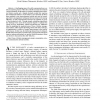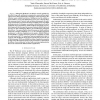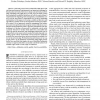INFOCOM
2000
IEEE
15 years 5 months ago
2000
IEEE
User-perceived latency is recognized as the central performance problem in the Web. We systematically measure factors contributing to this latency, across several locations. Our s...
101
click to vote
INFOCOM
2000
IEEE
15 years 5 months ago
2000
IEEE
TCP suffers from low performance over asynchronous transfer mode (ATM) networks. This is mainly because during phases of congestion, ATM drops cells without taking into account th...
INFOCOM
2000
IEEE
15 years 5 months ago
2000
IEEE
—We propose a framework for the creation and maintenance of multicast trees in hierarchical ATM networks. This framework aims at coping with an inherent difficulty of topology a...
INFOCOM
2000
IEEE
15 years 5 months ago
2000
IEEE
Abstract—A challenging aspect of mobile communications consists in exploring ways in which the available run time of terminals can be maximized. In this paper, we present a detai...
119
click to vote
INFOCOM
2000
IEEE
15 years 5 months ago
2000
IEEE
— An ad-hoc network of wireless static nodes is considered as it arises in a rapidly deployed, sensor based, monitoring system. Information is generated in certain nodes and need...
95
Voted
INFOCOM
2000
IEEE
15 years 5 months ago
2000
IEEE
—The future Internet is expected to support multicast applications with quality of service (QoS) requirements. To facilitate this, QoS multicast routing protocols are pivotal in ...
118
Voted
INFOCOM
2000
IEEE
15 years 5 months ago
2000
IEEE
—Although IP Multicast is an effective network primitive for best-effort, large-scale, multi-point communication, many multicast applications such as shared whiteboards, multi-pl...
105
click to vote
INFOCOM
2000
IEEE
15 years 5 months ago
2000
IEEE
—The ability of a web service to provide low-latency access to its contents is constrained by available network bandwidth. It is important for the service to manage available ban...
75
Voted
INFOCOM
2000
IEEE
15 years 5 months ago
2000
IEEE
124
Voted
INFOCOM
2000
IEEE
15 years 5 months ago
2000
IEEE
—Allocating resources for multimedia traffic flows with real-time performance requirements is an important challenge for future packet networks. However, in large-scale networks,...




